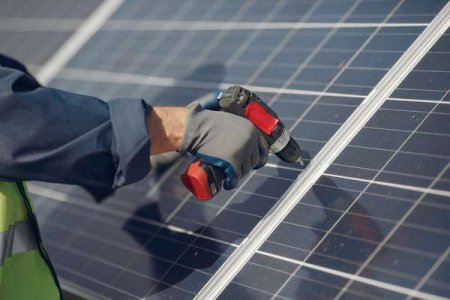From $2,000 to $0: Aussie Slashes Energy Costs with Massive Rebate
Imagine the shock of opening your electricity bill and finding the energy provider gives you credit for a change. For one Sydney family, that fantasy is now reality. After years of forking out $2,000 or more annually for power, 58-year-old Anthony Barrett decided to take matters into his own hands with solar panels and some hefty home batteries – and the result is astounding.
He once paid between $2,000 and $2,800 a year in energy costs. But after installing solar panels, inverters and two 10 kWh battery units (along with other energy-efficient upgrades), Anthony’s family not only wiped out their power bills, they now earn credits. In other words, the power company is paying them.
Rising energy bills have put a strain on many Australian households, especially seniors on fixed incomes. With energy prices soaring and the cost of living biting harder than ever, many Aussies are looking for ways to slash their power bills and future-proof their homes.
Solar panels have long been a popular way to take the sting out of electricity costs, but now there’s a new kid on the block: home battery storage. Thanks to the federal government’s new Cheaper Home Batteries Program, starting 1 July eligible households can get a 30% discount on the upfront cost of installing a battery system. It sounds like a win for consumers, right? Well, not everyone’s convinced – but more on the sceptics later. First, let’s look at what this ambitious battery rebate entails.
Anthony Barrett’s journey from bill shock to bill zero is an eye-opener. He was spending up to $2,800 a year on electricity – a figure all too familiar to many households Tired of the constant expense, he undertook a series of bold (and not cheap) moves to revolutionise his home’s energy usage.
He put solar panels on the roof, switched his appliances to efficient electric versions (including a heat-pump hot water system and an induction cooktop), and invested in two large lithium-ion batteries (10 kWh capacity each) to store excess solar power.
The total upgrade cost around $30,000, with the batteries alone accounting for roughly $21,000. “It was a crazy expense,” Anthony admits – the kind of outlay that would give anyone pause. But he’s quick to point out the long-term payoff: “We’ve had both batteries for about two years now and we’re thousands ahead. We’re earning well over $1,000 a year,” he says, referring to the credits his household now accumulates annually.
By his calculations, the battery system will pay for itself in roughly seven years. Given that the batteries came with a 10-year warranty and are expected to last about 12 years, the numbers stack up in his favour. In fact, Anthony and his family have even plotted out a 24-year plan, accounting for future battery replacements along the way.
“It’s a long-term thing and it’s a big upfront cost too. It’s nothing to be sneezed at,” he says of the investment. “Everyone’s different… we did a lot of research and so far on our little journey, it’s coming up exactly as was promised.”
Not every household will replicate the Barretts’ exact path – their solution was tailored to their needs and budget – but the story shows what’s possible. A power bill that was once over two grand a year has been transformed into a slight profit. Little wonder this tale grabbed headlines and imaginations around the country. And it arrives at a perfect time: just as a massive new government rebate scheme aims to help more Australians supercharge their homes in a similar fashion.
On July 1, the federal government officially launched the Cheaper Home Batteries Program, a $2.3 billion initiative aimed at turbocharging the adoption of home battery storage. Under this scheme, households (as well as businesses and community organisations) can receive roughly 30% off the cost of installing a battery system. The aim is straightforward: make it easier for everyday Australians to store the solar energy they generate and use it later when it’s most valuable – say, during the evening peak or on cloudy days.
It’s a logical next step in Australia’s renewable energy journey. About four million Australian homes already have solar panels on their rooftops, but for many, affordable battery storage has been the missing piece. Upfront cost has long been the major barrier – research found half of Australians feel the price of home-energy upgrades is simply too high, and a third find the process overwhelming.
Source: Bluegum Electrical Solutions / YouTube
The new rebate directly tackles that cost hurdle. For instance, a typical 10 kWh home battery system that might have cost well over $10,000 previously could now come down to roughly $6,700–$8,900 with the subsidy. In fact, the government estimates this program will knock up to $4,000 off the upfront price of an average 11.5 kWh battery unit – a serious chunk of change.
Crucially, this isn’t just about individual hip pockets. Canberra is also eyeing a broader payoff: reducing strain on the electricity grid and helping transition to a cleaner energy mix. If lots of homes can store their solar power and use it during peak times, it could flatten out demand spikes and even lower electricity prices for everyone in the long run. With the program expected to support the installation of an additional one million batteries by 2030, the ripple effects could be huge.
What’s the big draw of a home battery? In a nutshell, it’s the promise of energy independence and savings. By storing solar power, you can use your own electricity at night or when the sun isn’t shining, rather than buying from the grid. That means protection from ever-rising energy tariffs. There’s also the satisfaction of sticking it to the power companies and watching your meter run backwards!
The government’s modelling suggests the savings can be substantial. If you already have solar panels on your roof, adding a battery could save you up to about $1,100 extra per year on electricity. If you’re installing both new solar panels and a battery (and taking advantage of the rebates for both), the annual savings might reach as much as $2,300.
To put that in perspective, $2,300 is roughly 90% of an average family’s yearly power bill in Australia. In other words, you could nearly wipe out your bill. That’s not just a small dent – it’s practically a sledgehammer to your energy costs. With electricity rates climbing and general cost-of-living pressures, every dollar saved is a dollar back in your pocket (or pension) where it belongs.
As Anthony puts it, “Life in general is not cheap, it’s not getting any cheaper, but the thing we don’t worry about is our electricity bill.” Knowing that his family’s essentials can run on energy collected from their own roof provides immense peace of mind.
Beyond the personal savings, many see home batteries as a step toward a more sustainable future. Using more of your own solar power means drawing less from coal and gas-fired electricity – a win for the environment as well as your wallet. There’s a sense that by installing solar panels and a battery, ordinary people can be part of the broader solution to our energy challenges and get rewarded with lower bills. Indeed, energy experts point out that electrifying homes (with solar, batteries and efficient appliances) is one of the fastest and cheapest ways to decarbonise our built environment. It almost sounds too good to pass up.
For all the excitement, it’s important to remember that not everyone can shell out tens of thousands of dollars on a whim. Not everyone has $30,000 to spend on a full home-energy makeover like the Barretts did. The new rebate certainly makes the numbers a lot friendlier, and as battery prices continue to fall with advancing technology, payback periods should get even shorter.
But even after a 30% discount, we are still talking about several thousands of dollars upfront for a typical battery system. That’s a serious commitment, especially for retirees or anyone on a fixed income.
Then there’s the experience of Australians who jumped on the solar train early. Many were initially promised generous “feed-in tariffs” – payments for feeding surplus solar power back into the grid – but those rates have been slashed over time. One Victorian solar owner, Lee Bolger, invested in a 12 kW solar system a few years back. He paid roughly $12,700 out-of-pocket after rebates, expecting to save about $2,000 a year when feed-in tariffs were 12¢ per kWh.
But now his feed-in rate has been cut to around 6¢ – with some predictions it’ll drop further. As a result, Lee’s annual benefit has fallen to roughly $1,000, nearly doubling the time it will take to pay off his panels. No wonder he’s feeling a bit “indifferent” about the whole thing.
Stories like Lee’s help explain why many solar homeowners are now eyeing batteries. Feed-in tariffs have plummeted, so why sell your excess power for 6¢ only to buy it back at 30¢ later? Storing and using your own energy makes more sense than ever.
But even so, home batteries aren’t a one-size-fits-all solution. As Adam Corrigan, an energy-efficiency expert, notes, it really “depends on your household’s needs”. For example, the average NSW home uses about 20 kWh of electricity per day, so a 10–14 kWh battery can supply most of its night-time needs. But a battery could drain in just a few hours after sunset if you're running a power-hungry appliance like ducted air-conditioning.
Another factor to weigh is the payback time. We’ve heard the optimistic scenario – potentially $1,000+ a year saved. But real-world savings vary. If you tend to use a lot of power in the evening (when solar alone can’t help), you stand to save the most with a battery.
One analysis found that if you use most of your power after dark and pay around 32¢ per kWh for electricity, a battery might save you about $850 a year on your bills. On a roughly $7,000 battery system, that translates to around an 8–10 year payback, which conveniently is about the length of a typical battery warranty.
If energy prices rise further (very possible), the payback could be quicker; if not, it might be slower. The point is, you have to run the numbers for your situation. Batteries, like solar panels before them, are a long-term investment. Most come with 10-year warranties and are expected to last at least a decade or so. You’ll want the system to pay for itself well before it’s time for a replacement.
It’s also worth noting that government incentives aren’t uniform across the country. While the federal government is stepping up now, some state-level schemes have actually been winding back.
New South Wales, for instance, ended its broad battery rebate and replaced it with a narrower incentive for households that join virtual power plant programs. Victoria’s interest-free loans for solar batteries have wrapped up, and Queensland’s $4,000 battery grant closed at the end of 2024. South Australia and the ACT had early battery subsidy programs, which have either run their course or depleted their funding. In short, the federal rebate might be the best (or only) game in town at the moment for many Australians looking to cut the cost of a battery. If you’ve been sitting on the fence, now might indeed be the moment to act – before any further changes or cutbacks come along.
Source: Clean Energy Regulator / YouTube
Of course, a generous government subsidy always sparks debate about who benefits. Some have raised concerns about fairness. As one of our members bluntly put it, “So poor people, who can’t afford to pay the balance of the battery or who are only renting, will subsidise the cost of batteries for those who can get them.”
In other words, everyone’s chipping in via taxes, but only those who install a battery get to reap the reward. If you’re a renter or simply don’t have the spare cash, you might see your neighbour snag a big discount – and enjoy cheaper bills – thanks to public funds, while you’re left with nothing. Policymakers counter that the program’s broad benefits (like stabilising the grid and eventually lowering energy costs) will flow to all consumers, not just battery owners. But the debate over equity is unlikely to go away.
There’s political back-and-forth too. Opposition Leader Peter Dutton has argued that the battery plan is basically an admission that power prices will keep rising – saying Mr Albanese will have to “compensate people with batteries” because bills are going up. The government, unsurprisingly, rejects that claim, insisting the rebate is about investing in the future of energy, not covering up a failure.
At first glance, home batteries aren’t an impulse buy – whether one makes sense for you depends on your circumstances. If you’re keen to take the plunge, it pays to do some homework first. Here are a few tips experts suggest considering:
Australia’s new battery rebate is a bold attempt to future-proof our homes and fight the ever-rising cost of living. It’s ushering in what could be the biggest shift in home energy since the first rooftop solar panels started popping up in our suburbs. The idea of virtually eliminating your power bill – or even getting into credit – has moved from pipe dream to genuine possibility for tens of thousands of families. Anthony Barrett’s story is proof of that: he’s turned a $2,000-a-year expense into an energy surplus, essentially letting him live bill-free.
Still, the decision to jump on this opportunity isn’t cut-and-dried. It requires careful thought and often a significant financial outlay. The rewards – lower bills, more energy independence, a greener footprint – are enticing, but the risks (or at least the unknowns) are there too, from evolving tariffs to the durability of the technology.
For older Australians looking to save on power bills and be more self-sufficient, this program could be a game-changer. It’s available Australia-wide and works whether you’re adding a battery to an existing rooftop solar system or installing one alongside new solar panels. The whole thing is administered through the Clean Energy Regulator to keep it running smoothly. Basically, it’s a straightforward incentive to help you invest in battery storage now, and it even complements any state or territory battery rebates that might already exist.
Now, if you’re interested in taking advantage of this and want to learn more, the best step is to check out the official information online. The Department of Climate Change, Energy, the Environment and Water – which is running the program – has a dedicated Cheaper Home Batteries Program page that explains how the scheme works and what benefits it offers. There’s also a handy Eligibility Information page which breaks down the rules and requirements in case you’re wondering if your home or setup qualifies.
So, what do you think? Would you invest thousands now for the chance to wipe out your future power bills, or does the upfront cost and uncertainty make you hesitant?
Read more: Don’t let your super outlast you! Aussie seniors urged to spend (and save) wisely
He once paid between $2,000 and $2,800 a year in energy costs. But after installing solar panels, inverters and two 10 kWh battery units (along with other energy-efficient upgrades), Anthony’s family not only wiped out their power bills, they now earn credits. In other words, the power company is paying them.
Rising energy bills have put a strain on many Australian households, especially seniors on fixed incomes. With energy prices soaring and the cost of living biting harder than ever, many Aussies are looking for ways to slash their power bills and future-proof their homes.
Solar panels have long been a popular way to take the sting out of electricity costs, but now there’s a new kid on the block: home battery storage. Thanks to the federal government’s new Cheaper Home Batteries Program, starting 1 July eligible households can get a 30% discount on the upfront cost of installing a battery system. It sounds like a win for consumers, right? Well, not everyone’s convinced – but more on the sceptics later. First, let’s look at what this ambitious battery rebate entails.
From bill shock to bill zero: one family’s energy makeover
Anthony Barrett’s journey from bill shock to bill zero is an eye-opener. He was spending up to $2,800 a year on electricity – a figure all too familiar to many households Tired of the constant expense, he undertook a series of bold (and not cheap) moves to revolutionise his home’s energy usage.
He put solar panels on the roof, switched his appliances to efficient electric versions (including a heat-pump hot water system and an induction cooktop), and invested in two large lithium-ion batteries (10 kWh capacity each) to store excess solar power.
The total upgrade cost around $30,000, with the batteries alone accounting for roughly $21,000. “It was a crazy expense,” Anthony admits – the kind of outlay that would give anyone pause. But he’s quick to point out the long-term payoff: “We’ve had both batteries for about two years now and we’re thousands ahead. We’re earning well over $1,000 a year,” he says, referring to the credits his household now accumulates annually.
By his calculations, the battery system will pay for itself in roughly seven years. Given that the batteries came with a 10-year warranty and are expected to last about 12 years, the numbers stack up in his favour. In fact, Anthony and his family have even plotted out a 24-year plan, accounting for future battery replacements along the way.
“It’s a long-term thing and it’s a big upfront cost too. It’s nothing to be sneezed at,” he says of the investment. “Everyone’s different… we did a lot of research and so far on our little journey, it’s coming up exactly as was promised.”
Not every household will replicate the Barretts’ exact path – their solution was tailored to their needs and budget – but the story shows what’s possible. A power bill that was once over two grand a year has been transformed into a slight profit. Little wonder this tale grabbed headlines and imaginations around the country. And it arrives at a perfect time: just as a massive new government rebate scheme aims to help more Australians supercharge their homes in a similar fashion.
Inside the new battery rebate program
On July 1, the federal government officially launched the Cheaper Home Batteries Program, a $2.3 billion initiative aimed at turbocharging the adoption of home battery storage. Under this scheme, households (as well as businesses and community organisations) can receive roughly 30% off the cost of installing a battery system. The aim is straightforward: make it easier for everyday Australians to store the solar energy they generate and use it later when it’s most valuable – say, during the evening peak or on cloudy days.
It’s a logical next step in Australia’s renewable energy journey. About four million Australian homes already have solar panels on their rooftops, but for many, affordable battery storage has been the missing piece. Upfront cost has long been the major barrier – research found half of Australians feel the price of home-energy upgrades is simply too high, and a third find the process overwhelming.
Source: Bluegum Electrical Solutions / YouTube
The new rebate directly tackles that cost hurdle. For instance, a typical 10 kWh home battery system that might have cost well over $10,000 previously could now come down to roughly $6,700–$8,900 with the subsidy. In fact, the government estimates this program will knock up to $4,000 off the upfront price of an average 11.5 kWh battery unit – a serious chunk of change.
Crucially, this isn’t just about individual hip pockets. Canberra is also eyeing a broader payoff: reducing strain on the electricity grid and helping transition to a cleaner energy mix. If lots of homes can store their solar power and use it during peak times, it could flatten out demand spikes and even lower electricity prices for everyone in the long run. With the program expected to support the installation of an additional one million batteries by 2030, the ripple effects could be huge.
The appeal of going off-grid (and how much you could save)
What’s the big draw of a home battery? In a nutshell, it’s the promise of energy independence and savings. By storing solar power, you can use your own electricity at night or when the sun isn’t shining, rather than buying from the grid. That means protection from ever-rising energy tariffs. There’s also the satisfaction of sticking it to the power companies and watching your meter run backwards!
The government’s modelling suggests the savings can be substantial. If you already have solar panels on your roof, adding a battery could save you up to about $1,100 extra per year on electricity. If you’re installing both new solar panels and a battery (and taking advantage of the rebates for both), the annual savings might reach as much as $2,300.
To put that in perspective, $2,300 is roughly 90% of an average family’s yearly power bill in Australia. In other words, you could nearly wipe out your bill. That’s not just a small dent – it’s practically a sledgehammer to your energy costs. With electricity rates climbing and general cost-of-living pressures, every dollar saved is a dollar back in your pocket (or pension) where it belongs.
As Anthony puts it, “Life in general is not cheap, it’s not getting any cheaper, but the thing we don’t worry about is our electricity bill.” Knowing that his family’s essentials can run on energy collected from their own roof provides immense peace of mind.
Beyond the personal savings, many see home batteries as a step toward a more sustainable future. Using more of your own solar power means drawing less from coal and gas-fired electricity – a win for the environment as well as your wallet. There’s a sense that by installing solar panels and a battery, ordinary people can be part of the broader solution to our energy challenges and get rewarded with lower bills. Indeed, energy experts point out that electrifying homes (with solar, batteries and efficient appliances) is one of the fastest and cheapest ways to decarbonise our built environment. It almost sounds too good to pass up.
Counting the costs and considering the catch
For all the excitement, it’s important to remember that not everyone can shell out tens of thousands of dollars on a whim. Not everyone has $30,000 to spend on a full home-energy makeover like the Barretts did. The new rebate certainly makes the numbers a lot friendlier, and as battery prices continue to fall with advancing technology, payback periods should get even shorter.
But even after a 30% discount, we are still talking about several thousands of dollars upfront for a typical battery system. That’s a serious commitment, especially for retirees or anyone on a fixed income.
Then there’s the experience of Australians who jumped on the solar train early. Many were initially promised generous “feed-in tariffs” – payments for feeding surplus solar power back into the grid – but those rates have been slashed over time. One Victorian solar owner, Lee Bolger, invested in a 12 kW solar system a few years back. He paid roughly $12,700 out-of-pocket after rebates, expecting to save about $2,000 a year when feed-in tariffs were 12¢ per kWh.
But now his feed-in rate has been cut to around 6¢ – with some predictions it’ll drop further. As a result, Lee’s annual benefit has fallen to roughly $1,000, nearly doubling the time it will take to pay off his panels. No wonder he’s feeling a bit “indifferent” about the whole thing.
Stories like Lee’s help explain why many solar homeowners are now eyeing batteries. Feed-in tariffs have plummeted, so why sell your excess power for 6¢ only to buy it back at 30¢ later? Storing and using your own energy makes more sense than ever.
But even so, home batteries aren’t a one-size-fits-all solution. As Adam Corrigan, an energy-efficiency expert, notes, it really “depends on your household’s needs”. For example, the average NSW home uses about 20 kWh of electricity per day, so a 10–14 kWh battery can supply most of its night-time needs. But a battery could drain in just a few hours after sunset if you're running a power-hungry appliance like ducted air-conditioning.
Another factor to weigh is the payback time. We’ve heard the optimistic scenario – potentially $1,000+ a year saved. But real-world savings vary. If you tend to use a lot of power in the evening (when solar alone can’t help), you stand to save the most with a battery.
One analysis found that if you use most of your power after dark and pay around 32¢ per kWh for electricity, a battery might save you about $850 a year on your bills. On a roughly $7,000 battery system, that translates to around an 8–10 year payback, which conveniently is about the length of a typical battery warranty.
If energy prices rise further (very possible), the payback could be quicker; if not, it might be slower. The point is, you have to run the numbers for your situation. Batteries, like solar panels before them, are a long-term investment. Most come with 10-year warranties and are expected to last at least a decade or so. You’ll want the system to pay for itself well before it’s time for a replacement.
It’s also worth noting that government incentives aren’t uniform across the country. While the federal government is stepping up now, some state-level schemes have actually been winding back.
New South Wales, for instance, ended its broad battery rebate and replaced it with a narrower incentive for households that join virtual power plant programs. Victoria’s interest-free loans for solar batteries have wrapped up, and Queensland’s $4,000 battery grant closed at the end of 2024. South Australia and the ACT had early battery subsidy programs, which have either run their course or depleted their funding. In short, the federal rebate might be the best (or only) game in town at the moment for many Australians looking to cut the cost of a battery. If you’ve been sitting on the fence, now might indeed be the moment to act – before any further changes or cutbacks come along.
Source: Clean Energy Regulator / YouTube
Of course, a generous government subsidy always sparks debate about who benefits. Some have raised concerns about fairness. As one of our members bluntly put it, “So poor people, who can’t afford to pay the balance of the battery or who are only renting, will subsidise the cost of batteries for those who can get them.”
In other words, everyone’s chipping in via taxes, but only those who install a battery get to reap the reward. If you’re a renter or simply don’t have the spare cash, you might see your neighbour snag a big discount – and enjoy cheaper bills – thanks to public funds, while you’re left with nothing. Policymakers counter that the program’s broad benefits (like stabilising the grid and eventually lowering energy costs) will flow to all consumers, not just battery owners. But the debate over equity is unlikely to go away.
There’s political back-and-forth too. Opposition Leader Peter Dutton has argued that the battery plan is basically an admission that power prices will keep rising – saying Mr Albanese will have to “compensate people with batteries” because bills are going up. The government, unsurprisingly, rejects that claim, insisting the rebate is about investing in the future of energy, not covering up a failure.
Is a home battery right for you?
At first glance, home batteries aren’t an impulse buy – whether one makes sense for you depends on your circumstances. If you’re keen to take the plunge, it pays to do some homework first. Here are a few tips experts suggest considering:
- Do your homework: Research different battery brands, sizes and warranty terms, and get quotes from several installers to compare your options. Not all batteries are created equal, and prices can vary.
- Check your eligibility: Confirm that you meet the criteria for the federal rebate, and see if there are any remaining state or local incentives you can stack on top. (Some councils or energy providers offer additional rebates or special feed-in deals for battery owners.)
- Crunch the numbers: Take a close look at your current energy usage and bills, and calculate how a battery would change the equation. How much of your solar power do you currently export to the grid, and how much do you buy back at night? The more of your own solar you can use via a battery, the more you save.
- Think long term: Consider the lifespan of the battery (most last 10–15 years) and your future plans. A battery is a sizeable upfront investment, but it can pay off over time – especially as energy prices rise. Just make sure you’re likely to stay in the house long enough to see the payoff, or that a battery could add resale value if you sell.
The bottom line
Australia’s new battery rebate is a bold attempt to future-proof our homes and fight the ever-rising cost of living. It’s ushering in what could be the biggest shift in home energy since the first rooftop solar panels started popping up in our suburbs. The idea of virtually eliminating your power bill – or even getting into credit – has moved from pipe dream to genuine possibility for tens of thousands of families. Anthony Barrett’s story is proof of that: he’s turned a $2,000-a-year expense into an energy surplus, essentially letting him live bill-free.
Still, the decision to jump on this opportunity isn’t cut-and-dried. It requires careful thought and often a significant financial outlay. The rewards – lower bills, more energy independence, a greener footprint – are enticing, but the risks (or at least the unknowns) are there too, from evolving tariffs to the durability of the technology.
For older Australians looking to save on power bills and be more self-sufficient, this program could be a game-changer. It’s available Australia-wide and works whether you’re adding a battery to an existing rooftop solar system or installing one alongside new solar panels. The whole thing is administered through the Clean Energy Regulator to keep it running smoothly. Basically, it’s a straightforward incentive to help you invest in battery storage now, and it even complements any state or territory battery rebates that might already exist.
Now, if you’re interested in taking advantage of this and want to learn more, the best step is to check out the official information online. The Department of Climate Change, Energy, the Environment and Water – which is running the program – has a dedicated Cheaper Home Batteries Program page that explains how the scheme works and what benefits it offers. There’s also a handy Eligibility Information page which breaks down the rules and requirements in case you’re wondering if your home or setup qualifies.
So, what do you think? Would you invest thousands now for the chance to wipe out your future power bills, or does the upfront cost and uncertainty make you hesitant?
Read more: Don’t let your super outlast you! Aussie seniors urged to spend (and save) wisely
Last edited:









